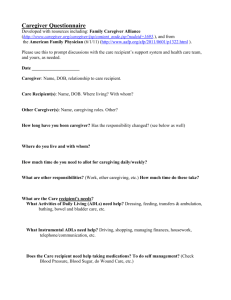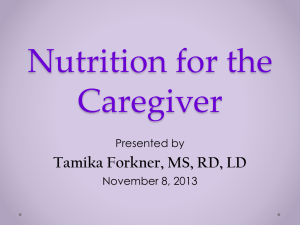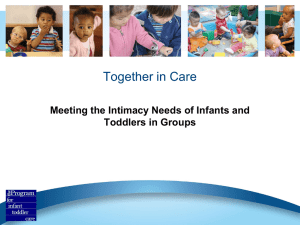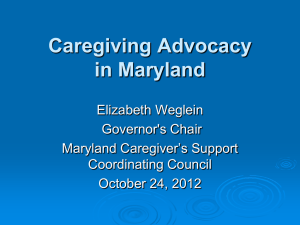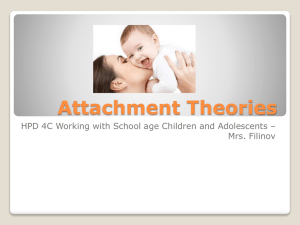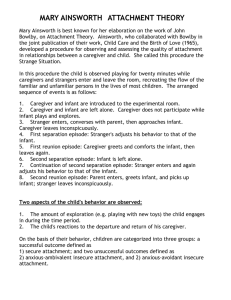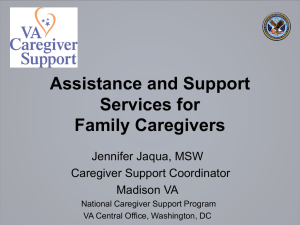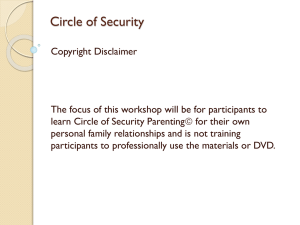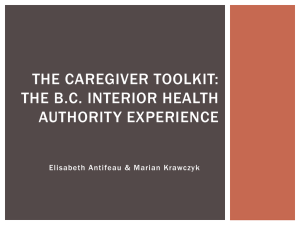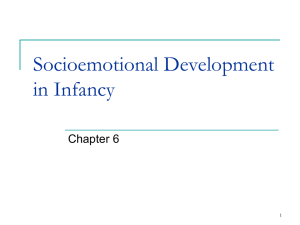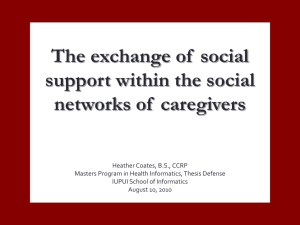Little Texans, Big Futures Orientation
advertisement
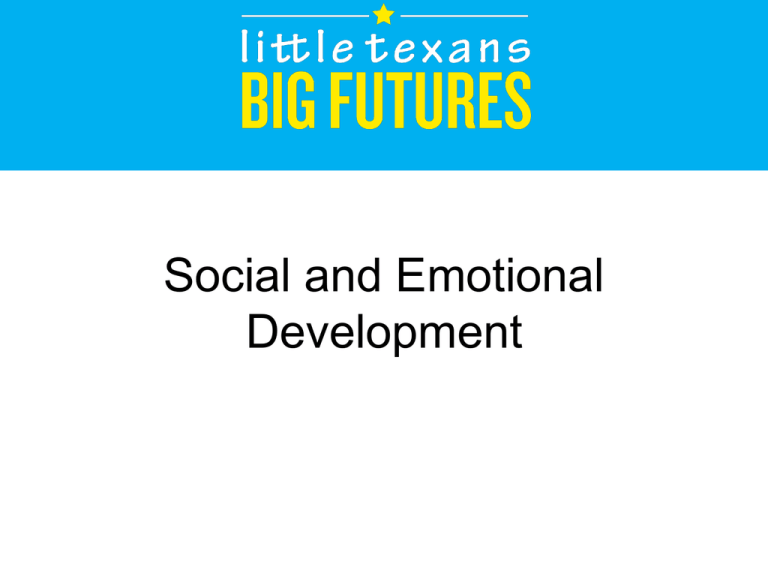
Social and Emotional Development Agenda Responsive Caregiving Attachment Self-Awareness Emotional Development and Self Regulation Relationships with Others Promoting Positive Interactions Inclusion Objectives Describe secure attachment and explain the caregiver’s role Create a strategy for responsive caregiving in a stressful situation List 4-5 classroom materials that can promote self-awareness Compile best practices for peaceful and appropriate transitions Develop an inclusion strategy for a child with special needs Responsive Caregiving Observe the child’s needs Respond appropriately Child receives the response and needs are met Attachment Caregiver Behavior • Responds appropriately, promptly, and consistently to needs • Little or no response to distressed child • Discourages crying and encourages independence Attachment Style Child Behavior Secure • Uses caregiver as secure base in exploration • Distressed when caregiver leaves, happy when they return • Seeks caregiver in stressful situations Avoidant • Little affective sharing in play • Little or no distress on departure • Child may be rebellious and has a lower self-image and self-esteem • • Inconsistent between appropriate and neglectful responses • Generally responds only after increased attachment behavior from the infant • Frightened or frightening behavior, abusive or neglectful Ambivalent/ Resistant Disorganized • • • Preoccupied with caregiver's availability Seeks contact but resists angrily when it is achieved Not easily calmed by stranger Always anxious because caregiver's availability is never consistent. • Displays no attachment behaviors towards caregiver Trust and Emotional Security Indicators: • Establishes secure relationships with primary caregiver • Differentiates between familiar and unfamiliar adults • Shows emotional connections and attachment to others while beginning to show independence Responsive Caregiving 0-8 Months • Hold, cuddle, and laugh with infants • Hold infants during bottle feeding time; talk to them in a calm and soothing tone • Notice, understand, and follow the signals of infants, such as cries of hunger or pain, turning away when full, or when ready to stop interacting • Display courteousness, warmth, and sensitivity when interacting with adults and children Responsive Caregiving 8-18 Months • Notice and be responsive to words, gestures, laughs, and cries • Stay close and visible while infants explore • Reassure them that you will return, explaining where you are going and when you will be back • Introduce them to new people and allow them time to become comfortable. 18-36 Months • Provide encouragement for trying activities and playing with new people • Accept that toddlers will need comfort items Responsive Caregiving 36-48 Months • Connect with three-year-olds on a daily basis, such as naptime or arrival • Respond with affection and care when approached by an upset or hurt three-year olds • Encourage independence and participation in new situations (“Go ahead, you can do it!”) Self-Awareness Erik Erikson’s Stages of Psychosocial Development Age Developmental Stage Birth – 12 months Trust vs. Mistrust 1-3 years Autonomy vs. Shame and Doubt A stage theory of development based on the mastery of one stage in order to successfully progress to the next. Self-Awareness • A clear and positive Sense of Self and identity • Self-Recognition of the baby in the mirror • Identifying the Categorical Self in social contexts • The Looking-Glass Self is understanding self based on the responses of others Self-Awareness Indicators: • Expresses needs and wants through facial expressions, sounds, or gestures • Develops awareness of self as separate from others • Shows confidence in increasing abilities • Shows awareness of relationship to family/ community/ cultural group Early Emotional Development At birth, infants can express contentment, distress, and interest. Within 6 months emotions begin to evolve from those. Distress Sadness Anger Fear Birth 3 Months 4 Months 5 Months Guilt and Shame 24 Months Self -Regulation Indicators • Begins to manage own behavior and demonstrates increasing control of emotion • Shows ability to cope with stress • Develops understanding of simple routines, rules or limitations Self-Regulation Caregivers can support self-regulation by: • Having realistic expectations of behavior • Not identifying a child by a negative behavior • Point out strengths and positive qualities • Balance the routine and the room arrangement with high-energy and peaceful activities and spaces • Use emotion words to help describe feelings • Be respectful of physical needs Relationships with Others Indicators of relationship development: • Shows interest in and awareness of others • Responds to and interacts with others • Begins to recognize and respond to the feelings and emotions of others and begins to show concern Caregiver Responses Learning Environment • Create an atmosphere of trust and cooperation • Room arrangement provides clues for behavior • Engaging and interesting materials keep children busy with play and learning • Organization promotes self-help skills and cooperation Caregiver Responses Routines • Consistent from day to day • Provide a logical and predictable order of events • Appropriately flexible for the needs of the children Transitions • Use consistent signals for transition • Create logical transitions during natural breaks in activity • Eliminate all waiting time Caregiver Responses Interactions • Build a relationship with the child • Provide valid choices • Redirect to a specific activity • Avoid power struggles Inclusion Aggression ADHD Social-communication deficits Autism Spectrum Disorders Restricted interests and repetitive behaviors Expressive/receptive language disorders Intellectual disabilities Social Anxiety Inclusion Strategies • Modify environment • Adjust expectations • Provide visual supports – Project cards – Picture schedules • Communication • Provide appropriate choices • Create a reward system Snack Read Home Conclusion • Action Plan • Q&A

